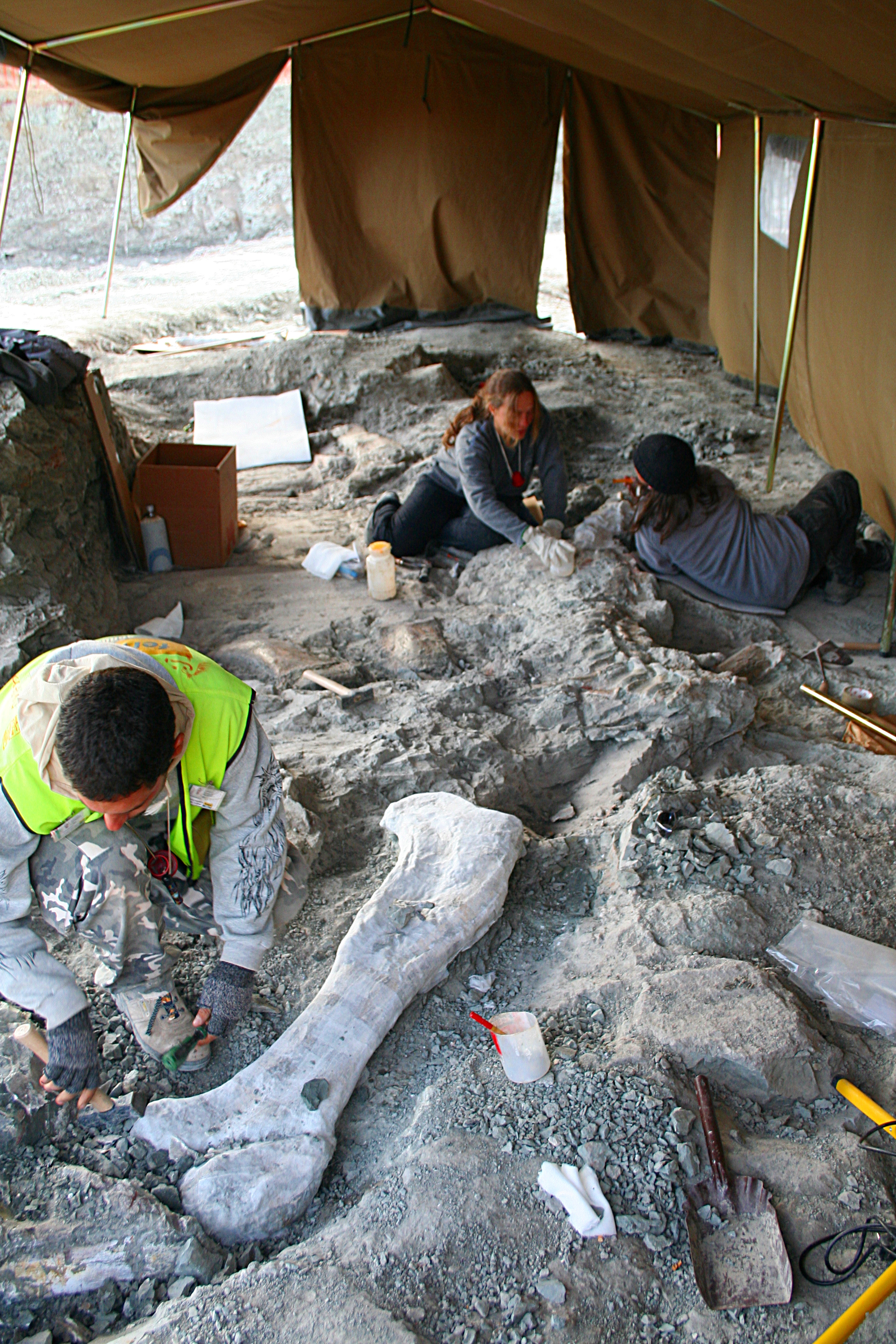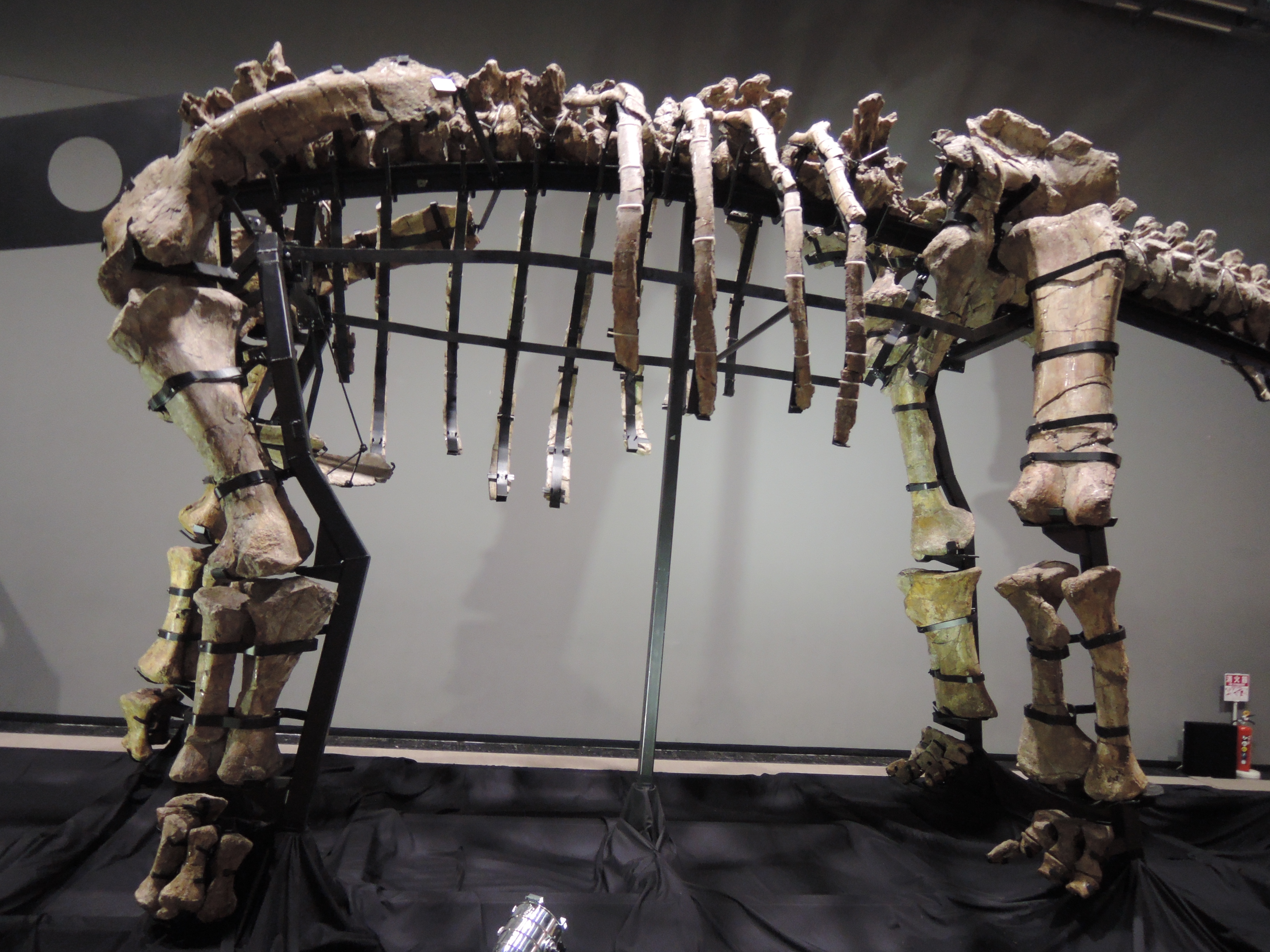|
Postcrania
Postcrania (postcranium, adjective: postcranial) in zoology and vertebrate paleontology is all or part of the skeleton apart from the skull. Frequently, fossil remains, e.g. of dinosaurs or other extinct tetrapods, consist of partial or isolated skeletal elements; these are referred to as ''postcrania''. There is some disagreement over whether the skull and skeleton belong to the same or different animals. One example is the case of a Cretaceous sauropod skull of ''Nemegtosaurus'' found in association with the postcranial skeleton ''Opisthocoelicaudia ''Opisthocoelicaudia'' is a genus of sauropod dinosaur of the Late Cretaceous Period discovered in the Gobi Desert of Mongolia. The type species is ''Opisthocoelicaudia skarzynskii''. A well-preserved skeleton lacking only the head and neck wa ...''. In paleoanthropological studies, reconstruction of relationship between various species/remains is considered to be better supported by cranial characters rather than postcranial c ... [...More Info...] [...Related Items...] OR: [Wikipedia] [Google] [Baidu] |
Zoology
Zoology ()The pronunciation of zoology as is usually regarded as nonstandard, though it is not uncommon. is the branch of biology that studies the Animal, animal kingdom, including the anatomy, structure, embryology, evolution, Biological classification, classification, Ethology, habits, and distribution of all animals, both living and extinction, extinct, and how they interact with their ecosystems. The term is derived from Ancient Greek , ('animal'), and , ('knowledge', 'study'). Although humans have always been interested in the natural history of the animals they saw around them, and made use of this knowledge to domesticate certain species, the formal study of zoology can be said to have originated with Aristotle. He viewed animals as living organisms, studied their structure and development, and considered their adaptations to their surroundings and the function of their parts. The Greek physician Galen studied human anatomy and was one of the greatest surgeons of the a ... [...More Info...] [...Related Items...] OR: [Wikipedia] [Google] [Baidu] |
Vertebrate Paleontology
Vertebrate paleontology is the subfield of paleontology that seeks to discover, through the study of fossilized remains, the behavior, reproduction and appearance of extinct animals with vertebrae or a notochord. It also tries to connect, by using the evolutionary timeline of evolution, timeline, the animals of the past and their modern-day relatives. The fossil record shows aspects of the meandering evolutionary path from early aquatic vertebrates to mammals, with a host of transitional fossils, though there are still large blank areas. The earliest known fossil vertebrates were heavily armored fish discovered in rocks from the Ordovician Period about 500 to 430 Ma (annum, megaannum, million years ago). The Devonian Period (395 to 345 Ma) brought in the changes that allowed primitive air-breathing fish to remain on land as long as they wished, thus becoming the first terrestrial vertebrates, the amphibians. Amphibians developed forms of reproduction and locomotion and a metabo ... [...More Info...] [...Related Items...] OR: [Wikipedia] [Google] [Baidu] |
Skeleton
A skeleton is the structural frame that supports the body of an animal. There are several types of skeletons, including the exoskeleton, which is the stable outer shell of an organism, the endoskeleton, which forms the support structure inside the body, and the hydroskeleton, a flexible internal skeleton supported by fluid pressure. Vertebrates are animals with a vertebral column, and their skeletons are typically composed of bone and cartilage. Invertebrates are animals that lack a vertebral column. The skeletons of invertebrates vary, including hard exoskeleton shells, plated endoskeletons, or Sponge spicule, spicules. Cartilage is a rigid connective tissue that is found in the skeletal systems of vertebrates and invertebrates. Etymology The term ''skeleton'' comes . ''Sceleton'' is an archaic form of the word. Classification Skeletons can be defined by several attributes. Solid skeletons consist of hard substances, such as bone, cartilage, or cuticle. These can be further ... [...More Info...] [...Related Items...] OR: [Wikipedia] [Google] [Baidu] |
Skull
The skull is a bone protective cavity for the brain. The skull is composed of four types of bone i.e., cranial bones, facial bones, ear ossicles and hyoid bone. However two parts are more prominent: the cranium and the mandible. In humans, these two parts are the neurocranium and the viscerocranium ( facial skeleton) that includes the mandible as its largest bone. The skull forms the anterior-most portion of the skeleton and is a product of cephalisation—housing the brain, and several sensory structures such as the eyes, ears, nose, and mouth. In humans these sensory structures are part of the facial skeleton. Functions of the skull include protection of the brain, fixing the distance between the eyes to allow stereoscopic vision, and fixing the position of the ears to enable sound localisation of the direction and distance of sounds. In some animals, such as horned ungulates (mammals with hooves), the skull also has a defensive function by providing the mount (on the front ... [...More Info...] [...Related Items...] OR: [Wikipedia] [Google] [Baidu] |
Dinosaur
Dinosaurs are a diverse group of reptiles of the clade Dinosauria. They first appeared during the Triassic period, between 243 and 233.23 million years ago (mya), although the exact origin and timing of the evolution of dinosaurs is the subject of active research. They became the dominant terrestrial vertebrates after the Triassic–Jurassic extinction event 201.3 mya; their dominance continued throughout the Jurassic and Cretaceous periods. The fossil record shows that birds are feathered dinosaurs, having evolved from earlier theropods during the Late Jurassic epoch, and are the only dinosaur lineage known to have survived the Cretaceous–Paleogene extinction event approximately 66 mya. Dinosaurs can therefore be divided into avian dinosaurs—birds—and the extinct non-avian dinosaurs, which are all dinosaurs other than birds. Dinosaurs are varied from taxonomic, morphological and ecological standpoints. Birds, at over 10,700 living species, are among ... [...More Info...] [...Related Items...] OR: [Wikipedia] [Google] [Baidu] |
Tetrapod
Tetrapods (; ) are four-limbed vertebrate animals constituting the superclass Tetrapoda (). It includes extant and extinct amphibians, sauropsids ( reptiles, including dinosaurs and therefore birds) and synapsids (pelycosaurs, extinct therapsids and all extant mammals). Tetrapods evolved from a clade of primitive semiaquatic animals known as the Tetrapodomorpha which, in turn, evolved from ancient lobe-finned fish (sarcopterygians) around 390 million years ago in the Middle Devonian period; their forms were transitional between lobe-finned fishes and true four-limbed tetrapods. Limbed vertebrates (tetrapods in the broad sense of the word) are first known from Middle Devonian trackways, and body fossils became common near the end of the Late Devonian but these were all aquatic. The first crown-tetrapods (last common ancestors of extant tetrapods capable of terrestrial locomotion) appeared by the very early Carboniferous, 350 million years ago. The specific aquatic ancestors ... [...More Info...] [...Related Items...] OR: [Wikipedia] [Google] [Baidu] |
Cretaceous
The Cretaceous ( ) is a geological period that lasted from about 145 to 66 million years ago (Mya). It is the third and final period of the Mesozoic Era, as well as the longest. At around 79 million years, it is the longest geological period of the entire Phanerozoic. The name is derived from the Latin ''creta'', "chalk", which is abundant in the latter half of the period. It is usually abbreviated K, for its German translation ''Kreide''. The Cretaceous was a period with a relatively warm climate, resulting in high eustatic sea levels that created numerous shallow inland seas. These oceans and seas were populated with now- extinct marine reptiles, ammonites, and rudists, while dinosaurs continued to dominate on land. The world was ice free, and forests extended to the poles. During this time, new groups of mammals and birds appeared. During the Early Cretaceous, flowering plants appeared and began to rapidly diversify, becoming the dominant group of plants across the Earth b ... [...More Info...] [...Related Items...] OR: [Wikipedia] [Google] [Baidu] |
Sauropod
Sauropoda (), whose members are known as sauropods (; from '' sauro-'' + '' -pod'', 'lizard-footed'), is a clade of saurischian ('lizard-hipped') dinosaurs. Sauropods had very long necks, long tails, small heads (relative to the rest of their body), and four thick, pillar-like legs. They are notable for the enormous sizes attained by some species, and the group includes the largest animals to have ever lived on land. Well-known genera include ''Brachiosaurus'', ''Diplodocus'', ''Apatosaurus'' and ''Brontosaurus''. The oldest known unequivocal sauropod dinosaurs are known from the Early Jurassic. ''Isanosaurus'' and ''Antetonitrus'' were originally described as Triassic sauropods, but their age, and in the case of ''Antetonitrus'' also its sauropod status, were subsequently questioned. Sauropod-like sauropodomorph tracks from the Fleming Fjord Formation (Greenland) might, however, indicate the occurrence of the group in the Late Triassic. By the Late Jurassic (150 million yea ... [...More Info...] [...Related Items...] OR: [Wikipedia] [Google] [Baidu] |
Nemegtosaurus
''Nemegtosaurus'' (meaning 'Reptile from the Nemegt') was a sauropod dinosaur from the Late Cretaceous Period of what is now Mongolia. It was named after the Nemegt Basin in the Gobi Desert, where the remains — a single skull — were found. The skull resembles diplodocoids in being long and low, with pencil-shaped teeth. However, recent work has shown that ''Nemegtosaurus'' is in fact a titanosaur, closely related to animals such as ''Saltasaurus'', ''Alamosaurus'' and ''Rapetosaurus''. Discovery and taxonomy The skull of ''Nemegtosaurus'' comes from the same beds as the titanosaur ''Opisthocoelicaudia'', which is known from a skeleton lacking the neck and skull. Originally, the referral of ''Nemegtosaurus'' to Diplodocoidea and ''Opisthocoelicaudia'' to Camarasauridae argued that the two represented different species. Both of these genera represent advanced titanosaurians, however, raising the possibility that the two are in fact the same animal. Relocation of the ''Nemegtosa ... [...More Info...] [...Related Items...] OR: [Wikipedia] [Google] [Baidu] |
Opisthocoelicaudia
''Opisthocoelicaudia'' is a genus of sauropod dinosaur of the late Cretaceous, Late Cretaceous Period discovered in the Gobi Desert of Mongolia. The type species is ''Opisthocoelicaudia skarzynskii''. A well-preserved skeleton lacking only the head and neck was unearthed in 1965 by Polish and Mongolian scientists, making ''Opisthocoelicaudia'' one of the best known sauropods from the Late Cretaceous. Tooth marks on this skeleton indicate that large carnivorous dinosaurs had fed on the wikt:carcass, carcass and possibly had carried away the now-missing parts. To date, only two additional, much less complete specimens are known, including part of a pectoral girdle, shoulder and a fragmentary tail. A relatively small sauropod, ''Opisthocoelicaudia'' measured about in length. Like other sauropods, it would have been characterised by a small head sitting on a very long neck and a barrel shaped trunk carried by four column-like legs. The name ''Opisthocoelicaudia'' means "posterior ca ... [...More Info...] [...Related Items...] OR: [Wikipedia] [Google] [Baidu] |







